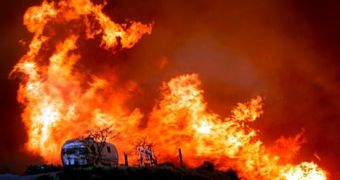US Forest Service scientists now say that, according to their investigations, climate change and global warming will up both the frequency and the fierceness of wildfires in the United States.
More precisely, it is their belief that, as the country's climate continues to alter, wildfire activity across the entire United States will up by 50% by the year 2050.
Several models indicate that the western regions will be hit the hardest, meaning that local fire activity could increase by 100% and even more within said time frame.
The specialists who pieced together this study have admitted to also being concerned about how the wildfires expected to hit the country in the years to come will impact on atmospheric conditions and how they will further influence ongoing climate changes.
Information shared with the public on the official website for the US Forest Service says that, whenever a wildfire hits a region, gases, particles, water and heat all get dispersed into the atmosphere.
Once there, these elements can fuel major climate events because of their toying with the established patterns for solar radiation absorption and scattering.
“During fire events or burning seasons, smoke particles reduce overall solar radiation absorbed by the atmosphere at local and regional levels.”
“At the global scale, fire emissions of carbon dioxide contribute substantially to the global greenhouse effect,” stated research meteorologist Yongqiang Liu.
Wildfires also impact on climate as a result of their altering ecosystems and triggering changes in land use.
As Yongqiang Liu put it, “Besides the atmospheric impacts, wildfires also modify terrestrial ecosystem services such as carbon sequestration, soil fertility, grazing value, biodiversity, and tourism. The effects can in turn trigger land use changes that in turn affect the atmosphere.”
The researchers warn that, given the ways in which an increase in wildfire activity across the United States can impact on climate patterns, more detailed investigations on the matter at hand are needed.
A detailed account of this study and its findings is made available to the public in the journal Forest Ecology and Management.

 14 DAY TRIAL //
14 DAY TRIAL //